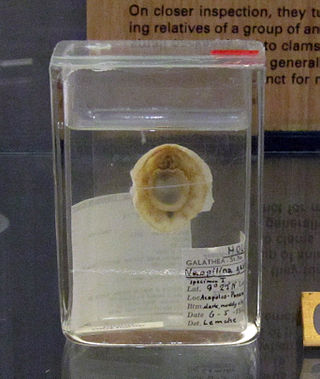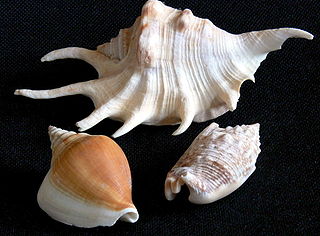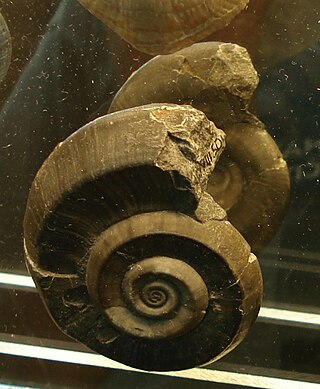
Gastropods, commonly known as slugs and snails, belong to a large taxonomic class of invertebrates within the phylum Mollusca called Gastropoda.

Monoplacophora, meaning "bearing one plate", is a polyphyletic superclass of molluscs with a cap-like shell, inhabiting deep sea environments. Extant representatives were not recognized as such until 1952; previously they were known only from the fossil record, and were thought to have become extinct 375 million years ago.

Caenogastropoda is a taxonomic subclass of molluscs in the class Gastropoda. It is a large diverse group which are mostly sea snails and other marine gastropod mollusks, but also includes some freshwater snails and some land snails. The subclass is the most diverse and ecologically successful of the gastropods.
Strepsodiscus is an extinct genus of very primitive fossil snail-like molluscs from the early part of the Late Cambrian of North America. The coiled, slightly asymmetrical shells are about 3 cm in height. It is not known whether these are shells of gastropods or monoplacophorans, which are more primitive mollusks.

The Bellerophontidae are an extinct family of specialized globose bellerophontids, Paleozoic and early Triassic mollusks of the class Gastropoda.

The Stromboidea, originally named the Strombacea by Rafinesque in 1815, is a superfamily of medium-sized to very large sea snails in the clade Littorinimorpha.

Scutus is a genus of large sea snails or limpets with the common name "shield shells". These are marine gastropod molluscs in the family Fissurellidae, the keyhole limpets and slit limpets.

Scenella is an extinct genus of fossil invertebrate animal which is generally considered to be a mollusc; at various times it has been suggested that this genus belongs with the gastropods, the monoplacophorans, or the helcionellids, although no firm association with any of these classes has been established. An affinity with the hydrozoa has been considered, although some authors oppose this hypothesis. A gastropod affinity is defended on the basis of six pairs of internal muscle scars, whilst the serially-repeated nature of these scars suggests to other authors a monoplacophoran affinity. However the specimens showing this scarring have not been convincingly shown to belong to the genus Scenella. A similarity to the Ediacaran Ovatoscutum has also been drawn.

Liotiidae is a family of small sea snails, marine gastropod mollusks in the clade Vetigastropoda.

Bellerophontoidea, common name "bellerophonts", is a superfamily of extinct planospirally-coiled globose molluscs. This superfamily is generally included within the Gastropoda, but may instead be a group of monoplacophorans. The taxon first appeared late in the Cambrian and continued until late in the Triassic.

Euomphalidae is an extinct family of Paleozoic to early Mesozoic marine molluscs which may be gastropods with anisostrophically coiled shells . The shells show a selenizone.
Stenothecidae is an extinct family of fossil univalved Cambrian molluscs which may be either gastropods or monoplacophorans.
Bucanellidae is an extinct family of Paleozoic molluscs of uncertain position, belonging either to Gastropoda (snails) or Monoplacophora. The family lived from the upper Cambrian to middle Permian and the shells are characterized by a relatively small median sinus in the upper margin of the aperture, and collabral (transverse) or spiral (longitudinal) threads covering the shell. The shells are planispirally coiled rather than trochospirally with a spire as is the case with most shelled gastropods.
Bucaniidae is an extinct family of Paleozoic molluscs of uncertain position possibly being either gastropods or monoplacophorans in the superfamily Bellerophontoidea. The family lived from the Lower Ordovician to the Devonian and have shells in which the apertural margins tend to flare. Most genera have a slit and selenizone, others some modification of this feature.

Macluritidae is an extinct family of relatively large, Lower Ordovician to Devonian, macluritacean gastropods(?), hypserstrophically coiled, that is dextral while appearing sinistral, of which the genus Maclurites is arch-typical. The base of their shells is flat or gently protruding while the upper side is generally concave.
The †Raphistomatidae is a taxonomic family of fossil sea snails, Paleozoic marine gastropod molluscs. This family was established by Koken in 1896. This family is found in the fossil record from the Upper Cambrian to the Middle Permian.
†Onychochilidae is an extinct family of small, fossil, upper Cambrian to lower Devonian molluscs. They have hyperstrophically coiled shells which generally have smooth whorls and elongate apertures. They are commonly considered to be gastropods, i.e. sea snails.

Euomphaloidea, originally Euomphalacea, is an extinct superfamily of marine molluscs that lived from the Early Ordovician to the Late Cretaceous, included in the Gastropoda but speculated as instead perhaps Monoplacophora.
The Kirengellids are a group of problematic Cambrian fossil shells of marine organisms. The shells bear a number of paired muscle scars on the inner surface of the valve.
The Helcionellacea is one of two taxonomic superfamilies of extinct primitive marine molluscs within the order Bellerophontida. This superfamily is thought to be the more primitive of the two superfamilies, the other being the Bellerophontacea. These molluscs are thought to be sea snails, marine gastropod mollusks, rather than monoplacophorans.










